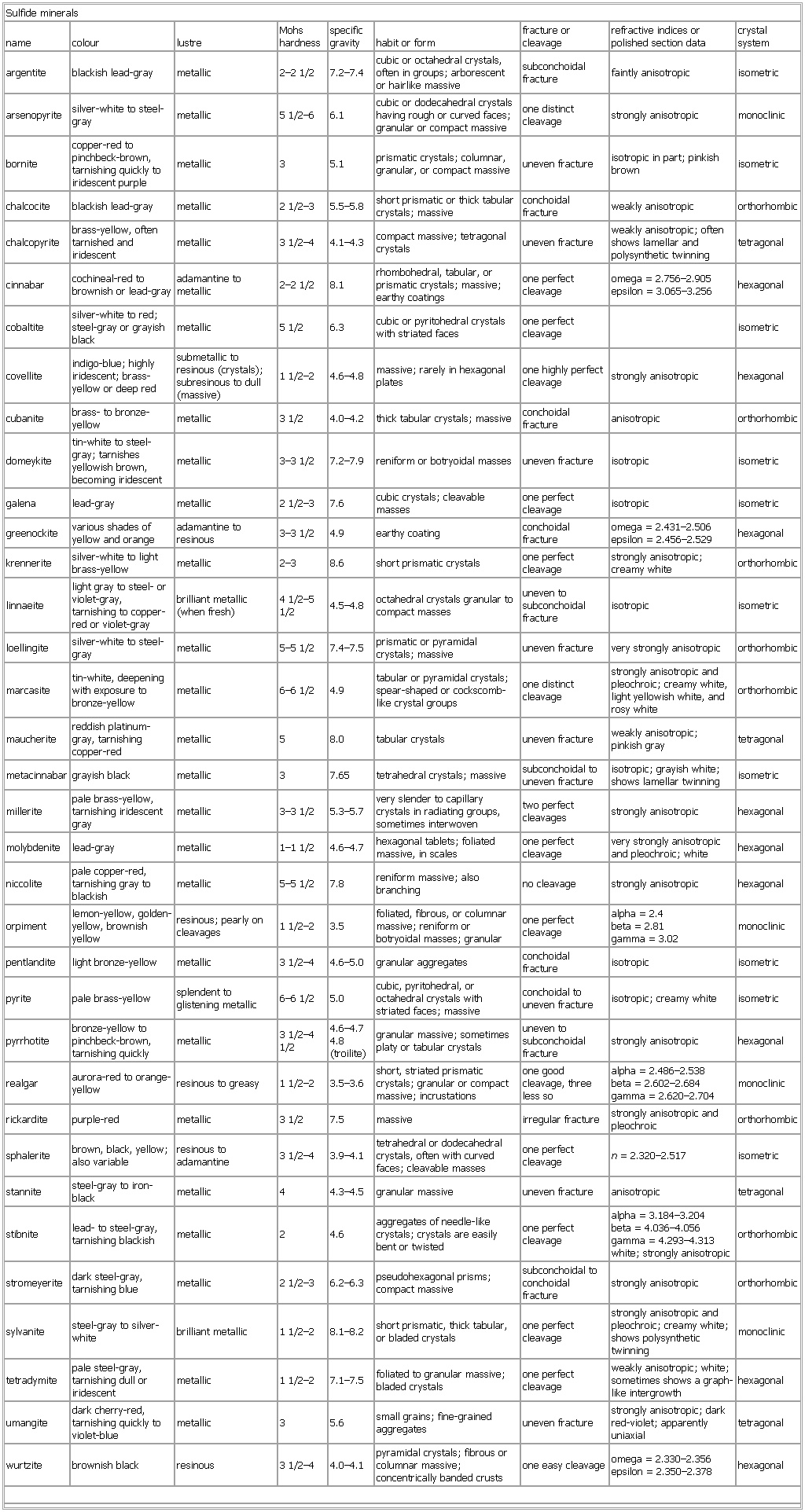- Sulfide minerals
-
▪ TableSulfide mineralsname colour lustre Mohs hardness specific gravity habit or form fracture or cleavage refractive indices or polished section data crystal systemargentite blackish lead-gray metallic 2–2 1/2 7.2–7.4 cubic or octahedral crystals, often in groups; arborescent or hairlike massive subconchoidal fracture faintly anisotropic isometricarsenopyrite silver-white to steel-gray metallic 5 1/2–6 6.1 cubic or dodecahedral crystals having rough or curved faces; granular or compact massive one distinct cleavage strongly anisotropic monoclinicbornite copper-red to pinchbeck-brown, tarnishing quickly to iridescent purple metallic 3 5.1 prismatic crystals; columnar, granular, or compact massive uneven fracture isotropic in part; pinkish brown isometricchalcocite blackish lead-gray metallic 2 1/2–3 5.5–5.8 short prismatic or thick tabular crystals; massive conchoidal fracture weakly anisotropic orthorhombicchalcopyrite brass-yellow, often tarnished and iridescent metallic 3 1/2–4 4.1–4.3 compact massive; tetragonal crystals uneven fracture weakly anisotropic; often shows lamellar and polysynthetic twinning tetragonalcinnabar cochineal-red to brownish or lead-gray adamantine to metallic 2–2 1/2 8.1 rhombohedral, tabular, or prismatic crystals; massive; earthy coatings one perfect cleavage omega = 2.756–2.905epsilon = 3.065–3.256 hexagonalcobaltite silver-white to red; steel-gray or grayish black metallic 5 1/2 6.3 cubic or pyritohedral crystals with striated faces one perfect cleavage isometriccovellite indigo-blue; highly iridescent; brass-yellow or deep red submetallic to resinous (crystals); subresinous to dull (massive) 1 1/2–2 4.6–4.8 massive; rarely in hexagonal plates one highly perfect cleavage strongly anisotropic hexagonalcubanite brass- to bronze-yellow metallic 3 1/2 4.0–4.2 thick tabular crystals; massive conchoidal fracture anisotropic orthorhombicdomeykite tin-white to steel-gray; tarnishes yellowish brown, becoming iridescent metallic 3–3 1/2 7.2–7.9 reniform or botryoidal masses uneven fracture isotropic isometricgalena lead-gray metallic 2 1/2–3 7.6 cubic crystals; cleavable masses one perfect cleavage isotropic isometricgreenockite various shades of yellow and orange adamantine to resinous 3–3 1/2 4.9 earthy coating conchoidal fracture omega = 2.431–2.506 epsilon = 2.456–2.529 hexagonalkrennerite silver-white to light brass-yellow metallic 2–3 8.6 short prismatic crystals one perfect cleavage strongly anisotropic; creamy white orthorhombiclinnaeite light gray to steel- or violet-gray, tarnishing to copper-red or violet-gray brilliant metallic (when fresh) 4 1/2–5 1/2 4.5–4.8 octahedral crystals granular to compact masses uneven to subconchoidal fracture isotropic isometricloellingite silver-white to steel-gray metallic 5–5 1/2 7.4–7.5 prismatic or pyramidal crystals; massive uneven fracture very strongly anisotropic orthorhombicmarcasite tin-white, deepening with exposure to bronze-yellow metallic 6–6 1/2 4.9 tabular or pyramidal crystals; spear-shaped or cockscomb-like crystal groups one distinct cleavage strongly anisotropic and pleochroic; creamy white, light yellowish white, and rosy white orthorhombicmaucherite reddish platinum-gray, tarnishing copper-red metallic 5 8.0 tabular crystals uneven fracture weakly anisotropic; pinkish gray tetragonalmetacinnabar grayish black metallic 3 7.65 tetrahedral crystals; massive subconchoidal to uneven fracture isotropic; grayish white; shows lamellar twinning isometricmillerite pale brass-yellow, tarnishing iridescent gray metallic 3–3 1/2 5.3–5.7 very slender to capillary crystals in radiating groups, sometimes interwoven two perfect cleavages strongly anisotropic hexagonalmolybdenite lead-gray metallic 1–1 1/2 4.6–4.7 hexagonal tablets; foliated massive, in scales one perfect cleavage very strongly anisotropic and pleochroic; white hexagonalniccolite pale copper-red, tarnishing gray to blackish metallic 5–5 1/2 7.8 reniform massive; also branching no cleavage strongly anisotropic hexagonalorpiment lemon-yellow, golden-yellow, brownish yellow resinous; pearly on cleavages 1 1/2–2 3.5 foliated, fibrous, or columnar massive; reniform or botryoidal masses; granular one perfect cleavage alpha = 2.4beta = 2.81gamma = 3.02 monoclinicpentlandite light bronze-yellow metallic 3 1/2–4 4.6–5.0 granular aggregates conchoidal fracture isotropic isometricpyrite pale brass-yellow splendent to glistening metallic 6–6 1/2 5.0 cubic, pyritohedral, or octahedral crystals with striated faces; massive conchoidal to uneven fracture isotropic; creamy white isometricpyrrhotite bronze-yellow to pinchbeck-brown, tarnishing quickly metallic 3 1/2–4 1/2 4.6–4.74.8 (troilite) granular massive; sometimes platy or tabular crystals uneven to subconchoidal fracture strongly anisotropic hexagonalrealgar aurora-red to orange-yellow resinous to greasy 1 1/2–2 3.5–3.6 short, striated prismatic crystals; granular or compact massive; incrustations one good cleavage, three less so alpha = 2.486–2.538beta = 2.602–2.684gamma = 2.620–2.704 monoclinicrickardite purple-red metallic 3 1/2 7.5 massive irregular fracture strongly anisotropic and pleochroic orthorhombicsphalerite brown, black, yellow; also variable resinous to adamantine 3 1/2–4 3.9–4.1 tetrahedral or dodecahedral crystals, often with curved faces; cleavable masses one perfect cleavage n = 2.320–2.517 isometricstannite steel-gray to iron-black metallic 4 4.3–4.5 granular massive uneven fracture anisotropic tetragonalstibnite lead- to steel-gray, tarnishing blackish metallic 2 4.6 aggregates of needle-like crystals; crystals are easily bent or twisted one perfect cleavage alpha = 3.184–3.204beta = 4.036–4.056gamma = 4.293–4.313white; strongly anisotropic orthorhombicstromeyerite dark steel-gray, tarnishing blue metallic 2 1/2–3 6.2–6.3 pseudohexagonal prisms; compact massive subconchoidal to conchoidal fracture strongly anisotropic orthorhombicsylvanite steel-gray to silver-white brilliant metallic 1 1/2–2 8.1–8.2 short prismatic, thick tabular, or bladed crystals one perfect cleavage strongly anisotropic and pleochroic; creamy white; shows polysynthetic twinning monoclinictetradymite pale steel-gray, tarnishing dull or iridescent metallic 1 1/2–2 7.1–7.5 foliated to granular massive; bladed crystals one perfect cleavage weakly anisotropic; white; sometimes shows a graph-like intergrowth hexagonalumangite dark cherry-red, tarnishing quickly to violet-blue metallic 3 5.6 small grains; fine-grained aggregates uneven fracture strongly anisotropic; dark red-violet; apparently uniaxial tetragonalwurtzite brownish black resinous 3 1/2–4 4.0–4.1 pyramidal crystals; fibrous or columnar massive; concentrically banded crusts one easy cleavage omega = 2.330–2.356 epsilon = 2.350–2.378 hexagonalSee as table:

* * *
Universalium. 2010.
